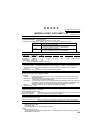
134
S H A R P
Date Revised :July. 22, 2002
Date Issued :May. 28, 1998
MATERIAL SAFETY DATA SHEET (2/3)
MSDS No. B-1020
Sec tio n 8. Exp osure Contr ol/Pe rsona l Prot ectio n
Engineering Measures
Ventilation: None required with intended use.
Control Parameters(As total dust)
OSHA-PEL(USA): 15mg/m
3
ACGIH-TLV(USA): 10mg/m
3
DFG-MAK(GER): 6mg/m
3
Worksafe-TWA(Austl.): 10mg/m
3
Personal Protective Equipment
Personal Protective Equipment
None required when used as intended in Sharp equipment. For use other than normal customer-operating procedures
(such as in bulk toner processing facilities), goggles and respirators may be required.
Hygiene Measures: Wash hands after handling.
Section 9. Physical and Chemical Properties
Appearance
Physical State: Solid Form: Powder Color: Black
Odor: Faint odor Explosion Properties: No data available
Particle Size(
µm): 5 - 15 Density(g/cm
3
): 1.2 (bulk density: 0.5)
Boiling Point: Not applicable Solubility in water: Negligible
Melting Point(°C): No data available Oxidizing Properties: No data available
Softening Point(°C): 120 - 130 * Ignition Temperature(°C): 450 *
Flash Point: Not applicable Vapor Pressure: Not applicable
pH: Not applicable
Partition Coefficient, n-Octanol/Water:
Not applicable
Section 10. Stability and Reactivity
Stability: Stable [ X ] Unstable [ ]
Hazardous Reactions: Dust explosion, like most finely divided organic powders.
Conditions to avoid: Electric discharge, throwing into fire.
Materials to Avoid: Oxidizing materials.
Hazardous Decomposition Products: CO, CO2
Section 11. Toxicological Information
Health Effects from Exposure: No symptoms expected with intended use.
Toxicological Data
Acute Toxicity:
Inhalation, LC50(mg/l): >0.74 (Rats,4hour exposure) * (This was the highest attainable concentration.)
Ingestion(oral), LD50(mg/kg): >5000 (Rats) *
Dermal, LD50(mg/kg): >2000 (Rats) *
Eye irritation: Non irritant (Rabbits) *
Skin irritation: Non irritant (Rabbits) *
Skin sensitizer: No data available
Mutagenicity: Negative * (AMES test)
(*= Based on data for other Products with similar ingredients)
Local Effects: see Chronic Toxicity or Long term Toxicity
Chronic Toxicity or Long Term Toxicity: Prolonged inhalation of excessive dust may cause lung damage.
It is attributed to "lung overloading", a generic response to excessive amounts of any
dust retained in the lungs for a prolonged interval. Use of this product, as intended,
does not result in inhalation of excessive dust.
In a study in rats by chronic inhalation exposure to a typical toner, a mild to moderate degree of
lung fibrosis was observed in 92% of rats in the high concentration(16mg/m
3
) exposure group,
and a minimal to mild degree of fibrosis was noted in 22% of the animals in the middle(4mg/m
3
)
exposure group. But no pulmonary change was reported in the lowest(1mg/m
3
) exposure group,
the most relevant level to potential human exposures.
Carcinogenicity
IARC Monographs: Not listed
NTP(USA): Not listed
OSHA Regulated(USA): Not listed
In 1996 the IARC reevaluated carbon black as a Group 2B carcinogen (possible human
carcinogen). This valuation is given to Carbon Black for which there is inadequate human
evidence, but sufficient animal evidence. The latter is based upon the development of lung
tumors in rats receiving chronic inhalation exposures to free carbon black at levels that induce
particle overload of the lung.
Studies performed in animal models other than rats have not demonstrated an association
between carbon black and lung tumors. Moreover, a two-year cancer bioassay using a typical
toner preparation containing carbon black demonstrated no association between toner
exposure and tumor development in rats.


















